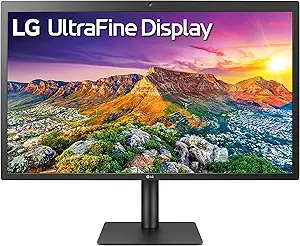In the realm of visual technology, LG and Dell stand as stalwarts, each offering a diverse range of monitors designed to cater to the needs of various users. From vibrant displays to ergonomic designs, these brands have earned their stripes in the competitive monitor market. In this comparative analysis, we delve into the distinctive features, performance metrics, and user experiences provided by LG monitors and Dell monitors, empowering consumers to make informed decisions in their quest for the perfect display.
Resolution
Dell and LG are two renowned brands in the monitor market, both offering a variety of models with different resolutions. Dell monitors, such as the Dell Ultrasharp U2720Q, offer 4K resolution (3840 x 2160 pixels), providing crisp and clear images. The high resolution is ideal for professional use, particularly for graphic design, video editing, and gaming. However, the high resolution may not be fully utilized for general office work or web browsing, and these monitors tend to be more expensive than lower resolution models. On the other hand, LG also offers 4K resolution monitors like the LG 27UK850-W. This monitor not only provides a sharp and vibrant display but also comes with HDR10 compatibility, which enhances the color and brightness range of the content. However, like Dell, the high resolution of LG monitors may not be necessary for all users and can come at a higher price point. Compared to other brands, both Dell and LG are known for their high-quality displays and wide range of options in terms of resolution. The choice between the two often comes down to personal preference and specific needs.
Size
Dell and LG are two renowned brands in the monitor market, each offering a variety of sizes to cater to different user needs. Dell monitors range from compact 19-inch models to expansive 49-inch ultrawide displays. For instance, the Dell Ultrasharp U4919DW is a 49-inch monitor that offers a vast, seamless workspace without the need for multi-monitor setups. However, such large-sized monitors may not be suitable for all users due to their high price and considerable desk space requirements. On the other hand, LG also offers a wide range of monitor sizes, from 21.5 inches to 49 inches. Their 49WL95C-W model, a 49-inch ultrawide monitor, provides an immersive viewing experience and is ideal for multitasking. LG's Nano IPS technology offers enhanced color reproduction, making it suitable for graphic designers and video editors. However, similar to Dell, the larger LG monitors also come with a higher price tag and require ample desk space. In comparison to other brands, both Dell and LG provide a diverse range of monitor sizes, catering to various user requirements, from everyday computing to professional graphic design and gaming.
Refresh Rate
Dell and LG are two of the most prominent brands in the monitor market, and they both offer a variety of monitors with different refresh rates. The refresh rate of a monitor is a critical aspect as it determines how many times the screen updates its image per second, which is particularly important for fast-paced gaming and high-definition video streaming. Dell monitors, such as the Dell Alienware AW3420DW, offer a refresh rate of up to 120Hz. This high refresh rate is beneficial for gamers as it provides smooth and seamless visuals, reducing motion blur and providing a more immersive gaming experience. However, Dell monitors tend to be more expensive compared to other brands with similar specifications. On the other hand, LG monitors, like the LG 27GL850, offer a higher refresh rate of up to 144Hz. This provides an even smoother visual experience, which is particularly noticeable in fast-paced action games. LG monitors also tend to be more affordable than Dell monitors with similar refresh rates. However, some users have reported issues with the color accuracy of LG monitors at higher refresh rates. Both brands offer monitors with adaptive sync technologies, such as Nvidia's G-Sync and AMD's FreeSync, to reduce screen tearing and stuttering at high refresh rates.
Response Time
Dell and LG monitors are two leading brands in the market, known for their quality and performance. When it comes to the aspect of response time, both have models that cater to different user needs. Dell's Alienware lineup, for instance, boasts a response time as low as 1ms, making it an excellent choice for gamers who require fast and seamless transitions. On the other hand, Dell's Ultrasharp monitors, designed for professional use, have a slightly higher response time, but still deliver crisp and clear images. LG monitors, particularly those in the UltraGear and UltraWide range, also offer a 1ms response time, making them competitive in the gaming sphere. However, LG has an edge in the IPS (In-Plane Switching) technology, where they offer a 1ms GTG (Gray to Gray) response time. This technology reduces the rate at which pixels can transition from one shade of gray to another, resulting in less motion blur and clearer images during fast-paced scenes. While both brands deliver high-quality monitors with impressive response times, the choice between Dell and LG may come down to specific user preferences and requirements.
Panel Type
Dell and LG monitors utilize different panel technologies, which significantly influence their performance and user experience. Dell monitors often use In-Plane Switching (IPS) panels, renowned for their superior color accuracy and wider viewing angles. The latest Dell Ultrasharp series, for instance, employs this technology, providing exceptional color reproduction, making it ideal for graphic designers and photographers. However, IPS panels have slower response times compared to other panel types, making them less suitable for fast-paced gaming. On the other hand, LG monitors often employ Vertical Alignment (VA) panels, as seen in their UltraGear gaming monitors. VA panels offer higher contrast ratios and deeper blacks compared to IPS panels, enhancing the viewing experience, particularly in dark scenes. They also have faster response times, which is crucial for minimizing motion blur in fast-paced gaming scenarios. However, VA panels have narrower viewing angles and less accurate color reproduction compared to IPS panels. Therefore, while LG monitors might be more appealing to gamers, Dell monitors might be more suitable for professionals requiring color accuracy.
Affordability
Dell and LG are two prominent brands in the monitor market, each offering a range of models at various price points. Dell monitors are known for their quality and reliability, and they come with a wide range of features. However, these features often come with a higher price tag. For instance, the Dell UltraSharp U2720Q, a 4K monitor with USB-C connectivity and an adjustable stand, is priced at around $600. On the other hand, LG monitors are often more affordable. For example, the LG 27UK850-W, also a 4K monitor with USB-C and an adjustable stand, is priced at around $450. While Dell monitors are generally more expensive, they are also often equipped with the latest technologies, such as HDR and color accuracy, which can justify the higher price for professionals. On the contrary, LG monitors, while being more budget-friendly, do not compromise on quality. They also offer a variety of features, including gaming-specific enhancements like faster refresh rates and response times. However, when compared to other brands, both Dell and LG offer competitive pricing for their monitors. The choice between the two often comes down to specific needs and budget constraints.
Reputation
Dell and LG are both reputable brands in the monitor market, each with their unique strengths and technologies. Dell monitors are well-regarded for their consistent quality, durability, and excellent after-sales service. They have been a trusted brand for many businesses and professionals due to their high-performance monitors like the Dell Ultrasharp series, which offers superior color accuracy and resolution. Dell also stays at the forefront of technology with features like USB-C connectivity and InfinityEdge bezels for a virtually borderless viewing experience. On the other hand, LG monitors have a strong reputation for their innovative features and cutting-edge technology. They are known for their IPS (In-Plane Switching) panels that offer excellent color reproduction and wide viewing angles, making them a favorite among graphic designers and video editors. LG's Ultragear gaming monitors are also highly praised for their fast refresh rates and low input lag. However, while LG monitors are generally reliable, some users have reported issues with quality control and customer service. Compared to Dell, LG's after-sales service may not be as consistent. Nevertheless, both brands are highly competitive and offer a range of options to suit different user needs and preferences.
Picture Quality
Dell and LG are two prominent brands in the monitor market, both offering a range of models with varying picture quality. Dell monitors, such as the Dell Ultrasharp U2719DX, are renowned for their excellent picture quality, offering QHD resolution with a 2560 x 1440 pixel density, which provides crisp, clear images. Dell monitors also feature In-Plane Switching (IPS) technology, which offers wide viewing angles and vibrant colors. However, some users have reported that Dell monitors can suffer from backlight bleeding, which can slightly degrade the picture quality. On the other hand, LG monitors, like the LG 27UK850-W, also offer impressive picture quality. This model features 4K UHD resolution with a 3840 x 2160 pixel density, providing even more detailed and sharper images than many Dell models. LG monitors also use IPS technology, but they have the added benefit of HDR10, which enhances the color and brightness of the image, providing a more immersive viewing experience. However, while LG monitors generally offer excellent picture quality, some users have reported issues with the consistency of their color accuracy. Comparatively, both brands offer high-quality displays, but LG's higher resolution and HDR10 support may give it a slight edge in picture quality.
Production Selection
Dell and LG are two prominent brands in the monitor market, each offering a wide range of products to cater to different user needs. Dell monitors are known for their diverse product selection, ranging from budget-friendly options like the Dell SE2419HR to high-end, professional-grade monitors like the Dell Ultrasharp U3219Q. The brand is also recognized for its innovative technologies such as InfinityEdge, which offers virtually borderless viewing, and ComfortView, a feature that reduces harmful blue light emissions. However, Dell's product range, while extensive, may not be as varied in terms of design and aesthetic appeal as some competitors. On the other hand, LG monitors also boast a broad product selection, with offerings that span from the budget category, such as the LG 24MK400H-B, to premium options like the LG 34WK95U-W UltraWide monitor. LG is renowned for its IPS (In-Plane Switching) technology that ensures accurate color and wide viewing angles, as well as its Nano IPS tech that delivers stunning visuals. Additionally, LG's product line is appreciated for its sleek and modern designs. However, some users have noted that LG's menu system can be less intuitive compared to other brands. Comparatively, both brands offer a wide selection of products, but LG may have an edge in terms of design aesthetics, while Dell might be preferred for its user-friendly features.
Related Video
Conclusion
Dell and LG monitors both offer a variety of features and technologies that make them appealing to different types of users. Dell monitors are known for their high-quality displays, with technologies like IPS (In-Plane Switching) for better color reproduction and viewing angles, and OLED for deeper blacks and higher contrast ratios. Dell also offers features like USB-C connectivity for easier connection to laptops and other devices, and their UltraSharp series is highly regarded for professional use due to its color accuracy and consistency. However, Dell monitors are generally more expensive than other brands, and some users have reported issues with quality control and customer service. On the other hand, LG monitors are known for their value for money, offering high-quality displays at a lower price point than many competitors. LG offers technologies like Nano IPS, which combines the benefits of IPS with quantum dot technology for even better color reproduction, and their UltraGear series is highly regarded among gamers for its high refresh rates and low response times. LG also offers features like Thunderbolt 3 connectivity for fast data transfer and charging, and their monitors are generally well-built and reliable. However, some users have reported issues with backlight bleed on LG monitors, and their customer service is also a common point of criticism.



















